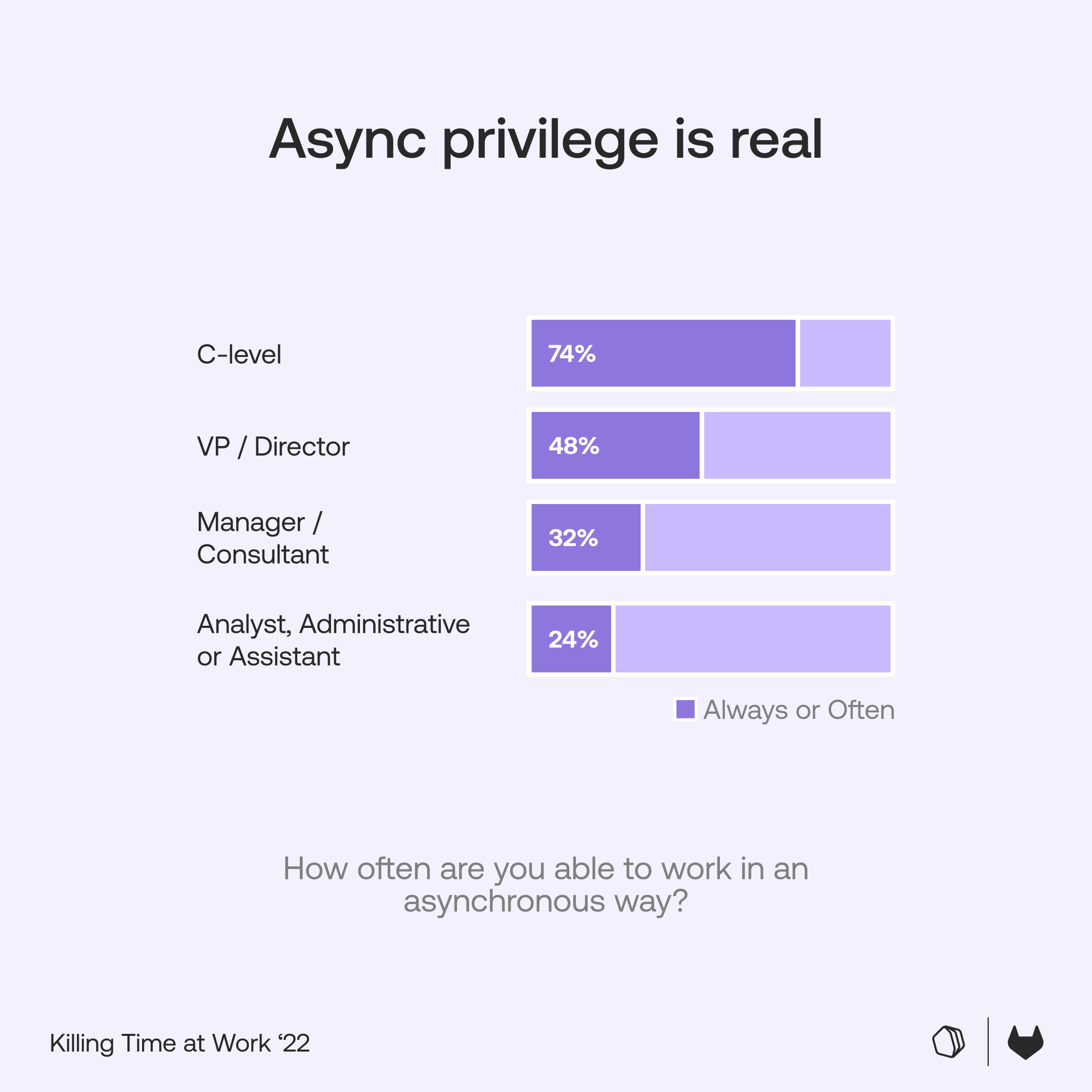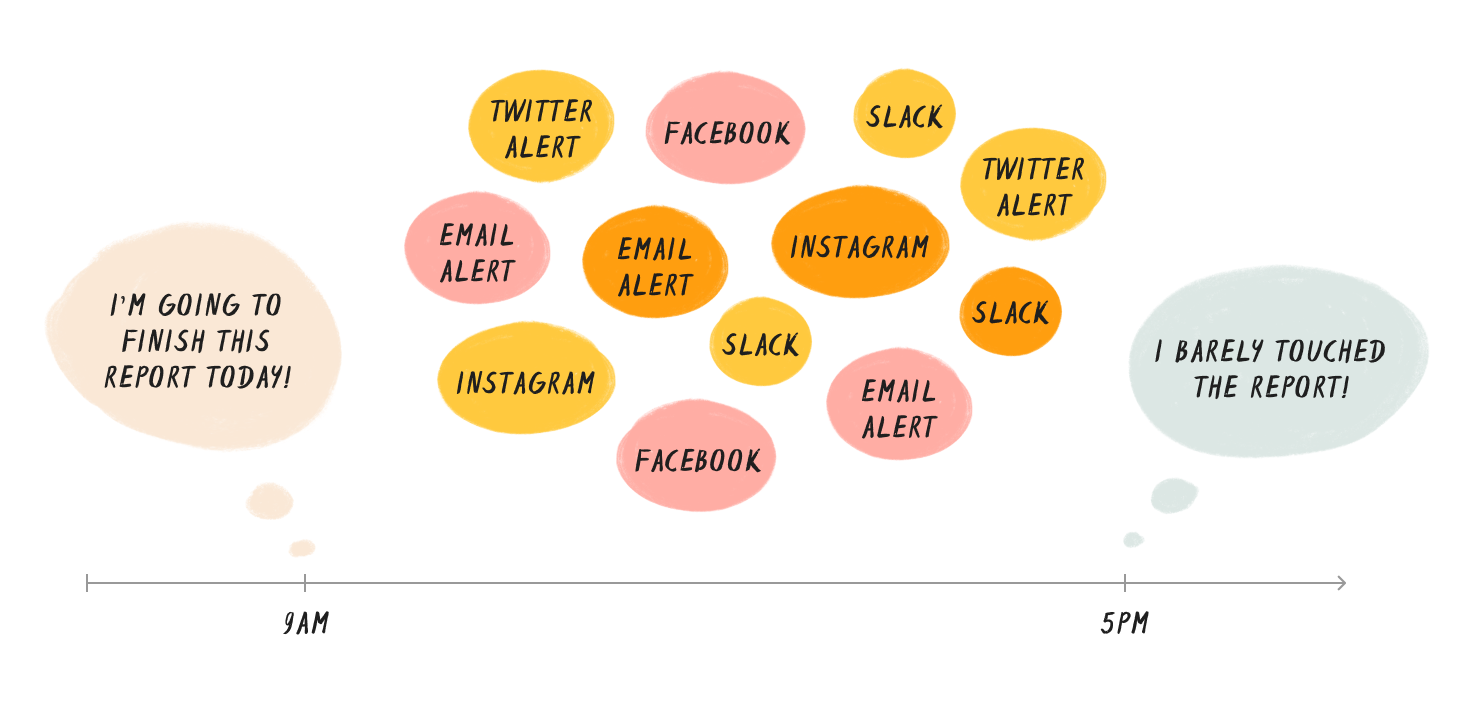Fellow CEOs: We need to talk about async privilege
By Tariq Rauf

A couple months back, GitLab and Qatalog published the results of a joint survey on the state of flexibility and async communication in the workplace.
As soon as I read it, I knew I wanted to get Qatalog's founder Tariq Rauf on the newsletter to give a CEO's perspective on digital presenteeism, managers' productivity paranoia, and the async privilege enjoyed by company leaders while more junior staff continue to have their schedules dictated to them. Rules for thee but not for me.
As Tariq puts it: "What we found should be a wake-up call to company leaders everywhere."
Enjoy and see you next week,
– Becky and the Twist team
With hundreds of millions of us now working remotely, the rationale behind the rigid 9-to-5 is starting to show cracks, too. If the work is getting done on time, why should it make any difference to companies when it happens?
In the way that remote work has freed people to work where they work best, the movement toward async-first work frees people to work when they work best.
- It allows for deep work, by removing the requirement to respond to messages instantly and join endless meetings.
- It respects the fact that we are all productive at different times of the day and gives everyone the flexibility to make that possible.
- It allows people with caregiving responsibilities to build their working day around them.
- And, if you can get it right, it allows companies to work seamlessly with team members from all over the world.
Given the significance of the shift that’s underway, we at Qatalog set out to uncover the reality for knowledge workers in a new report we created with our async-first friends at GitLab.
Lots of companies were talking a good game on flexible working, but how many of their staff were actually able to work asynchronously, controlling their own hours and communicating on their own schedules? What we found should be a wake-up call to company leaders everywhere.
The benefits of async work aren’t enjoyed equally
We surveyed 2,000 knowledge workers in the US and the UK, made up of remote, hybrid, and office-based workers.
As expected, we found that 65% had more flexibility to choose their working hours compared to before the pandemic, but relatively few reported working asynchronously. Just 9% said they ‘always’ work async, while 24% said they were able to work this way ‘often’. Two-thirds of remote workers still feel they need to be available online at roughly the same time as their coworkers.

But when we dug into the findings in more detail, a more complicated picture emerged. The ability to work asynchronously was strongly correlated with seniority, and it wasn’t even close. 74% of C-suite execs said they could work async regularly (always or often), compared to just 24% of their junior colleagues.
While remote workers enjoy more scheduling flexibility on the margins, those gains have largely happened by default rather than by design. Without overarching guidelines, policies, and norms to support more flexible, async work, those who already have the most power in the workplace are reaping the benefits, while those with less power continue to have their schedules dictated to them. Async — and the myriad benefits of flexibility it unlocks — has become a privilege reserved for senior staff.

Why should leaders care?
One of the biggest benefits of async is the ability to create uninterrupted blocks of time for deep work. If we stick to our old practices, this enormous advantage remains just out of reach for many. And the individual contributors who most need focused time to execute well currently receive the least. Encouraging async practices is one of the biggest keys to unlocking the collective potential of an entire company working remotely.
But it’s also critical for attracting and retaining top talent. In the same study, we found that 66% would consider resigning if they were prevented from working flexible hours. 43% said they would take a pay cut for greater schedule flexibility. In short, if your employees don’t feel able to work flexibly, they will quit. If that doesn’t persuade you that this is something you should care about, I don’t know what will.
So, here are some thoughts on why 'async privilege' is happening, and how we as leaders can overcome it:
Managers find it easier to overcome 'digital presenteeism' pressures
Our research identified 'digital presenteeism' as one of the biggest barriers to asynchronous work. In other words, employees feel pressure to show colleagues and bosses they are available online and 'working' during traditional working hours, resulting in time spent being 'present', even if it’s not productive.
The average worker spends an extra 67 minutes online every day to avoid suspicion from colleagues that they aren’t working hard enough.
54% of workers said they felt pressure to be visibly online at certain times of the day. As a result the average worker spends an extra 67 minutes online every day to avoid suspicion from colleagues that they aren’t working hard enough.
However, the more senior you become, the easier it is to resist this pressure. Let’s imagine you want to do some deep work for a few hours and switch off all notifications. Or perhaps you want to run some errands in the afternoon and plan to catch up in the evening. For a C-suite exec, it’s no trouble at all. The higher up the ladder you get, the fewer people there are to ask questions about what you’ve been doing with your time. I can attest to this from personal experience.
By contrast, those at the bottom have a whole host of people above them and they fear that their work won’t be seen. While we built Qatalog specifically to help solve this problem, it's still something I have to think about from a cultural perspective, too.
'Productivity paranoia' on the part of managers
We all saw the headlines when Elon Musk told Tesla workers they needed to come back to the office and stop ‘pretending to work’ at home. Then you had Jamie Dimon, the chief executive of JPMorgan Chase, who has repeatedly criticized remote work, saying it ‘doesn’t work for people who want to hustle’.
While the research so far shows that remote workers are, in fact, likely to be more productive than their office-bound counterparts, attitudes like Musk’s and Dimon’s contribute to prevailing 'productivity paranoia' on the part of managers. In a recent survey of 20,000 people, Microsoft found that 85% of leaders think hybrid work has 'made it challenging to have confidence that employees are being productive'. In other words, bosses don’t trust their teams further than they can physically see them.
85% of leaders think hybrid work has “made it challenging to have confidence that employees are being productive”.
In that context, it will come as no surprise that our study with GitLab found that two-thirds of knowledge workers (63%) believe that management and senior leadership within their organization 'prefer a traditional culture with employees in the office'.
For remote workers in these companies, presenting themselves as 'online' is likely seen as the next best thing to counter their bosses’ misgivings, exacerbating the digital presenteeism problem.
A lack of planning and due consideration
As a CEO, if you really want to, it’s entirely possible to clear your schedule and focus on what’s most important. By contrast, a junior employee’s day is often at the mercy of those above them. Let’s imagine one called Alex, a Graduate Analyst working in a financial services company.
At a moment's notice, Alex could be given an urgent task and expected to complete it, without anyone asking if they had made alternative plans for their time. Tasks can trickle in for Alex throughout the day from various people in the company, completely ad hoc, and Alex always tries to acknowledge them immediately —otherwise it might look as though they’re not working. Even if it’s not actually urgent, far too often there’s not enough context provided, and no clear guidance on when it needs to be done, meaning Alex has to follow up and clarify the details. The team is often guilty of thinking their priorities should be everyone’s priority.

I was often on the receiving end of this kind of behavior early in my career as an architect, where I had to drop work I was doing mid-flight as more senior folks gave me grunt work to complete. You’re also rewarded with more grunt work if you’re really good at getting things done.
As any proponent of asynchronous work will tell you, this approach is deeply flawed. Alex ends up spending more time replying to the endless stream of questions and tasks, context switching, and checking for the next Slack message, rather than actually getting stuff done. Alex had planned to go for a walk at lunchtime, but then another task came in from a VP and they ended up having a back and forth on Slack for 20 minutes, by which point Alex felt it was too late. Today’s top priority, marked as critical, has barely been started.
How leaders can counteract async privilege
Actively encourage async
Leaders need to be explicit that working async is not only permitted, but actively encouraged.
- Explain why time for deep, focused work is important for the company’s success.
- Highlight the opportunity for more flexible schedules, allowing everyone to fit their work around life.
- Talk about digital presenteeism and why it’s counterproductive.
Then you need to ensure this message is delivered consistently during All-Hands meetings, but also in 1:1s, to ensure the rest of the senior team is onboard and understands why you’re making the change. Discuss the progress you’re making and be honest where things aren’t working.
Role model at the top
No matter what is said in the All-Hands, most people will still take cues from their line manager to gauge the preferred behavior. The data suggests that many leaders and managers are already working asynchronously, and it’s worth talking about your working style with your team, so they can understand how you’re working and why.
Tell them you won’t be replying to messages between certain hours so you can spend time with your kids, or because you want focus time. Sharing your own async approach can help normalize delayed responses, allowing your team to imagine how they might benefit too.
Be considerate in communicating, planning, & prioritizing work
Leaders must also become more considerate in terms of their communication cadence and group their messages together, rather than just endlessly pinging their team with different questions throughout the day. Small changes can make a big difference here too.
For example, if I message a team member and it doesn’t need an urgent response, I will always preface with ‘no rush' or ‘for tomorrow’, especially if it’s at an odd hour.
Wherever possible, tasks should be provided in batches — with enough time to complete them — and with ample context and detail, so that the assignee can plan it into their schedule. There will always be emergencies that need urgent attention, but emergencies should be the exception, not the rule. Thoughtful planning and clear guidance on prioritization can mitigate the vast majority of these instances.
For example, at Qatalog it’s often the engineers that are needed at short notice to fix any bugs that crop up. But we operate on a rota system, which means only one or two people are ever ‘on-call’, and everyone else can focus. Broadly speaking, being more disciplined with regards to planning and more ruthless with prioritizing can consistently yield positive effects that extend far beyond asynchronous working. So it is well worth investing the time at the outset.
Take control of the tech
Technology plays a fundamental role in how we work, but it increasingly feels as though many tools we use on a daily basis have been designed to compete for our attention, rather than prioritize our needs and objectives.
You could argue this affects everyone equally — we all use the same tools with the same default settings. In my experience, however, junior employees are much less likely to modify or turn off notifications for all the reasons cited above.
As a basic first step to address this disparity, managers should proactively ask their team how they’ve changed their tech settings to make async and deep work possible. Again, this is about actively encouraging the behavior you want to see, not just giving permission. It also helps to normalize the conversation around these issues and opens up a discussion about what’s expected and how you want to work together.
Asynchronous communication is a huge competitive advantage for any company that can master it. Not only does it get the best out of people, but it also attracts and retains top tier talent. That’s why async privilege should be of huge concern to anyone running a business, as it is effectively a limiting factor to your success.
That’s not to say fixing these disparities will be easy. It will take time, careful thought, and consistent effort, but the mutual benefits to both employees and the bottom line should provide plenty of motivation.
When it comes to pushing back against ASAP work culture, every conversation counts!
3 things worth sharing
- This extremely topical Vox article on the bosses ordering workers back to the office from the comfort of their own homes:
"It’s unfair, but then management was always privileged," she said, referring to the people above her. "This is just a new way of showing that privilege."
- This 6-minute video tour of how the team at Keep Productive uses Twist threads to organize their teamwork:
"I've been a Twist user for three years and I've found the change in our communication has been pretty drastic."
- This Dutch court ruling that companies demanding webcam surveillance as a condition of employment is a human rights violation:
"Instructions to keep the webcam turned on is in conflict with the respect for the privacy of the workers."
Spotlight from the community
Big thanks to everyone who contributed to last week's member thread. Y'all are asking the hard questions. Expect several of them to show up in future member threads.
I'll be sending out a "Work async, not ASAP" mug to Konrad for his excellent questions that I know are on a lot of people's minds:
How can I, as a developer with no real power in the company I work at, implement an async workflow for everyone? How can we integrate and train junior people in an async environment?
What’s Twist? Twist is an async messaging app for teams burned out by real-time chat, meetings, and email.
You don’t need to use Twist to get a ton of value out of this newsletter and community. But if the topics we talk about resonate with you, there’s a good chance the app will too. See what makes Twist different →
🌎 Built asynchronously by the fully remote team at Doist
